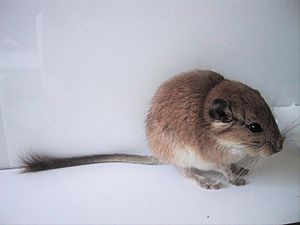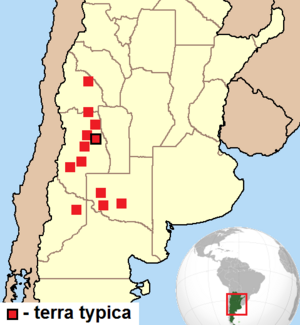Plains viscacha rat facts for kids
Quick facts for kids Plains viscacha rat |
|
|---|---|
 |
|
| Conservation status | |
| Scientific classification | |
| Genus: |
Tympanoctomys
|
| Species: |
barrerae
|
 |
|
The plains viscacha rat is a small rodent that lives in Argentina. It is also called the plains vizcacha rat, red viscacha rat, or red vizcacha rat. Its scientific name is Tympanoctomys barrerae. It belongs to the Octodontidae family, which includes other rodents like degus.
Contents
About the Plains Viscacha Rat
The plains viscacha rat is a medium-sized rodent. It has a big head, a long tail, and short ears. Adults are about 13 cm (5.1 in) long, not including their tail. Their tail is usually around 15 cm (5.9 in) long. These rats weigh about 90 g (3.2 oz). Male rats are a little bigger than females.
Their fur is a buff-yellow color. Their belly is white. The tip of their tail is dark brown.
Where They Live
The plains viscacha rat lives only in central western Argentina. You can find them in Mendoza Province and western La Pampa. They live in dry places like desert scrubland, sand dunes, and salt flats. They live at heights between 300 and 1,400 m (980 and 4,590 ft) above sea level.
Sadly, their homes are being destroyed. This is a threat to the plains viscacha rat.
Their Daily Life and Habits
Plains viscacha rats like to be alone. They are also nocturnal, which means they are active at night. During the day, they sleep in their burrows.
They build amazing burrow systems inside large dirt mounds. These mounds can be about 13.6 by 8.7 m (45 by 29 ft) wide and 1.25 m (4 ft 1 in) tall. Each mound has about 23 entrances to the burrows. Inside, their burrow system can have up to three levels. It has many rooms and tunnels that lead to dead ends.
What They Eat
These rats are herbivorous, meaning they only eat plants. They mostly eat plants that grow in salty areas, like Atriplex and Suaeda. Sometimes, they also eat grass.
They have a clever way to eat salty plants. They use their teeth and the bristles around their mouths to scrape off salt from the leaves. They throw the salt away before eating the leaves. Even with this trick, they still eat some salt. To deal with this, their bodies make very salty urine. This helps them keep enough water in their bodies.
Life Cycle
Baby plains viscacha rats are born blind. They weigh about 4 g (0.14 oz). Their eyes open when they are about six days old. They start to eat solid food when they are ten days old.
Amazing Genetics
This amazing rodent has the most chromosomes of any known mammal! As of 2017, it has 102 chromosomes.
Scientists believe it might be the first mammal found to be "tetraploid." This means it has four sets of chromosomes instead of the usual two. It's like its chromosomes doubled up a long time ago! They think it might be related to the mountain viscacha rat, which has fewer chromosomes. Scientists are still studying exactly how this happened.
Even though it's called a "rat," this animal is not a true rat. It is a caviomorph, which means it's related to animals like guinea pigs and chinchillas.
See also
 In Spanish: Vizcacha roja para niños
In Spanish: Vizcacha roja para niños



